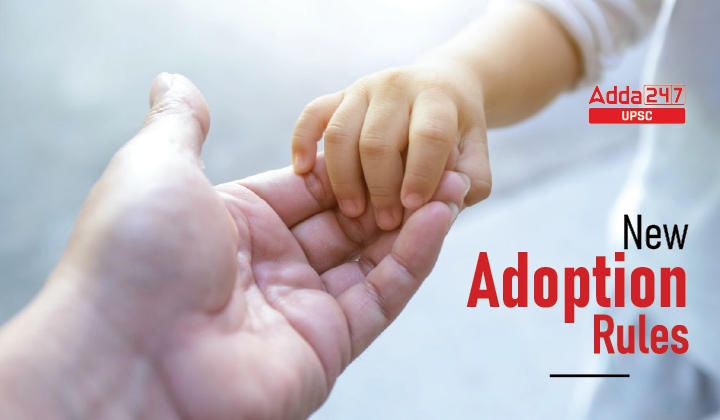Table of Contents
New Adoption Rules- Relevance for UPSC Exam
General Studies II- Issues Related to Children.
In News
There is confusion over the implementation of new adoption rules that require the transfer of adoption petitions from courts to District Magistrates (DMs).
- DMs have been empowered to give adoption orders instead of courts.
- All cases pending before courts have to be now transferred.
- Hundreds of adoptive parents in the country are now concerned that the transfer process will further delay what is already a long and tedious process.
- There are questions whether an order passed by the executive will pass muster when an adopted child’s entitlements on succession and inheritance are contested before a court.
Adoption in India: A background
- In 2015, the then Minister for Women and Child Development centralized the entire adoption system by empowering Central Adoption Resource Authority (CARA).
- It was empowered to maintain in various specialized adoption agencies, a registry of children, prospective adoptive parents as well as match them before adoption.
- This was aimed at checking rampant corruption and trafficking as child care institutions and NGOs could directly give children for adoption after obtaining a no-objection certificate from CARA.
DMs to issue Adoption Orders
- The Parliament passed the Juvenile Justice (Care and Protection of Children) Amendment Bill, 2021 in order to amend the Juvenile Justice Act (JJ Act), 2015.
- The key changes include authorizing District Magistrates and Additional District Magistrates to issue adoption orders under Section 61 of the JJ Act by striking out the word “court”.
- This was done “in order to ensure speedy disposal of cases and enhance accountability,” according to a government statement.
- The DMs have also been empowered under the Act to inspect child care institutions as well as evaluate the functioning of district child protection units, child welfare committees, juvenile justice boards, specialized juvenile police units, child care institutions etc.
Concern over the revised rules
- Parents, activists, lawyers and adoption agencies will have to be transferred and the process will have to start afresh.
- A delay in such an order can often mean that a child can’t get admission into a school because parents don’t yet have a birth certificate.
- Parents and lawyers also state that neither judges, nor DMs are aware about the change in the JJ Act leading to confusion in the system and delays.
- DMs don’t handle civil matters that bestow inheritance and succession rights on a child.
- If these rights are contested when a child turns 18, a judicial order is far more tenable to ensure the child is not deprived of his or her entitlements.
- The Central Adoption Resource Authority (CARA) says there are nearly 1,000 adoption cases pending before various courts in the country.
- This is not such a huge burden.
The Adoption procedure in India
- Adoptions in India are governed by two laws:
- Hindu Adoption and Maintenance Act, 1956 (HAMA): It is a parent-centric law that provides son to the son-less for reasons of succession, inheritance, continuance of family name and for funeral rights and later adoption of daughters was incorporated because kanyadaan is considered an important part of dharma in Hindu tradition.
- Juvenile Justice Act, 2015: It handles issues of children in conflict with law as well as those who are in need of care and protection and only has a small chapter on adoptions.
- Both laws have their separate eligibility criteria for adoptive parents.
- Those applying under the JJ Act have to register on CARA’s portal after which a specialized adoption agency carries out a home study report.
- After it finds the candidate eligible for adoption, a child declared legally free for adoption is referred to the applicant.
- Under HAMA, a “dattaka hom” ceremony or an adoption deed or a court order is sufficient to obtain irrevocable adoption rights.
Issues with child adoption in India
- Parent-centrism: The current adoption approach is very parent-centered, but parents must make it child-centered.
- Age of child: Most Indian parents also want a child between the ages of zero and two, believing that this is when the parent-child bond is formed.
- Institutional issues: Because the ratio of abandoned children to children in institutionalized care is lopsided, there are not enough children available for adoption.
- Lineage discrimination: Most Indians have a distorted view of adoption because they want their genes, blood, and lineage to be passed down to their children.
- Red-tapism: Child adoption is also not so easy task after the Juvenile Justice Rules of 2016 and the Adoption Regulations of 2017 were launched.
Practical issues in adoption
- There are no rules for monitoring adoptions and verifying sourcing of children and determining whether parents are fit to adopt.
- There are many problems with the adoption system under CARA but at the heart of it is the fact that there are very few children in its registry.
- According to the latest figures there are only 2,188 children in the adoption pool, while there are more than 31,000 parents waiting to adopt a child.




 TSPSC Group 1 Question Paper 2024, Downl...
TSPSC Group 1 Question Paper 2024, Downl...
 TSPSC Group 1 Answer key 2024 Out, Downl...
TSPSC Group 1 Answer key 2024 Out, Downl...
 UPSC Prelims 2024 Question Paper, Downlo...
UPSC Prelims 2024 Question Paper, Downlo...
